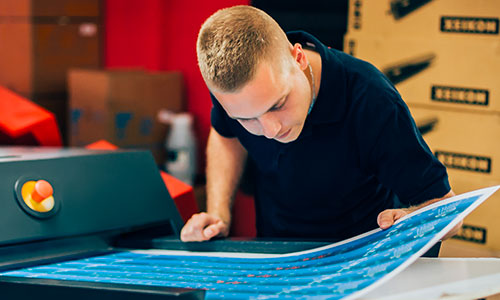PROFILES
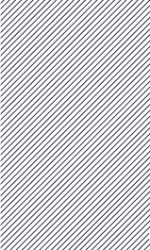
What are your interests and talents? The printing industry offers many opportunities for people with different kinds of skills. Which role will bring out the best in you?
Commerce
Account manager
An account manager is responsible for the management of sales and relationships with important customers of the printing company.
Sales support
A sales support specialist provides troubleshooting assistance for customer orders, account statuses and is responsible for the relationship with all customers (small and large).
Printjob pricing
A printjob pricing specialist provides financial calculations for printjob quotations, supporting the account managers and sales units of the company.
Communicator advisor
A communication advisor is responsible for developing and providing communications strategies, services, products, tools and advice to customers of the printing company.
Cross media advisor
A cross media advisor is responsible for developing and providing cross media strategies, services, products, tools and advice to customers of the printing company.


Prepress
Printjob manager
A printjob manager organises all printjobs in an efficient routing scheme of all the necessary steps in the prepress, printing and binding processes.
IT database operator
An IT database operator is responsible for the handling of all files in the web-to-print database within an automated printjob management software system.
Photographer
A photographer is responsible for producing creative and technically correct pictures for advertising print and cross media production orders.
Graphic designer
A graphic designer creates visual concepts, using computer software or by hand, to communicate ideas that inspire, inform, and captivate consumers. They develop the overall layout and production design for applications, such as advertisements, brochures, magazines, websites and much more.
DTP operator
A DTP (Desktop Publishing) operator is a technician who prepares printing processes by formatting, setting and composing text and graphics into a suitable form. Prepress operators create a prepress proof, or sample of what the finished product will look like. In many printing contracts, the client at this stage decides whether the print can go through as planned. In most printing companies, a DTP operator is also responsible for the computer-to-plate production process.
Web designer
A web designer is a creative job to plan and create internet sites and web pages, many of which combine text with sounds, pictures, graphics and video clips. A web designer is responsible for creating the design and layout of a website or web pages, using images, HTML, CSS, and JavaScript to do so.
Quality control worker
A quality control worker records the results of their inspections through test reports. When they find defects, inspectors notify supervisors and help to analyse and correct production problems.
Computer-to-plate operator
A computer-to-plate operator prepares printing plates to be used as printing forms for high volume printing in various printing processes. Plates are exposed or engraved from digital sources with computer-to-plate technology. Specific processes are used for production of offset plates and for flexography plates.
Gravure cylinder preparation
A gravure cylinder preparation operator is responsible for all steps in making a roto gravure cylinder. This includes the engraving and chrome plating of the cylinder surface, and transportation of the cylinder to the printing press.
Preparation of screen printing forms
Screen printing forms are prepared by coating screen meshes with a light sensitive stencil material and expose the image onto it. Screen printing is used for graphic and functional printing on various substrates such as plastic foils, glass, paper or textiles and many more.
Die-cutting/embossing preparation
A die-making craftsman is a specialist in making two matching engraved dies in a specific shape to cut or change the surface of the material.
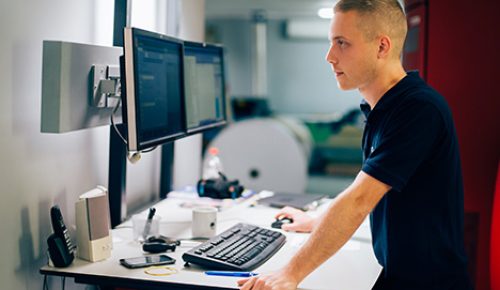
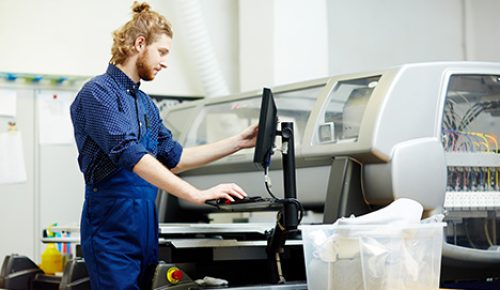
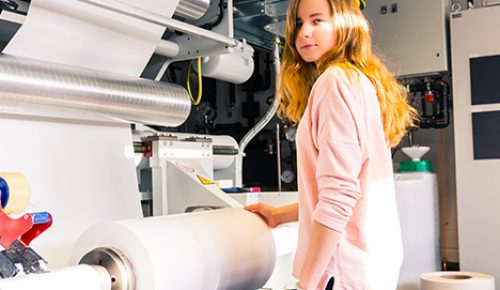

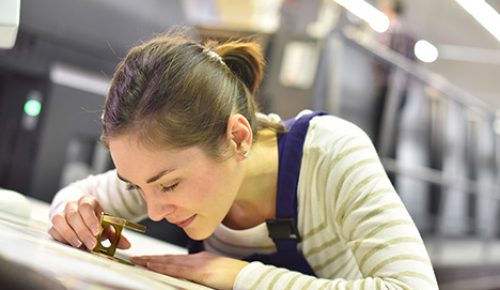
Press
Sheet-fed offset printer
Sheet-fed offset printers handle an offset press in order to print an image. The offset press transfers an inked image from the plate to a rubber blanket before to print it onto the printing surface. Most offset presses are computer operated and controlled, with four, eight or ten colour units.
Web-fed offset printer
Web-fed offset printers work in a team of printers in order to print high circulation of newspapers or magazines within one production run. The highly automated process implies continuously printing on paper from different paper rolls, assembling of paper webs, folding and cutting, inserting of other prints, and print addressing from databases with inkjet printers. All in one production flow.
(Web) gravure printer
Gravure press operators work with gravure presses, where the image is engraved directly on a cylinder. They prepare the inks and set up the press and monitor it during the operation, taking care of safety and resolving problems. Gravure printing is a highly automated process and implies the build in and extend of the engraved cylinders in and out the press machine.
Flexo printer
Flexographic press operators use a flexographic relief plate to print on almost any material. The relief plate is inked and pressed onto the material to be printed. The large central cylinder flexo presses have eight to ten inking units and are computer operated and controlled.
Screen printer
Screen printers are mastering a printing technique where a mesh is used to transfer ink onto a substrate, except in areas made impermeable to the ink by a blocking stencil. Industrial screen printing is often used to print on textiles or print functional materials such as conductive inks onto a great variety of substrates that are hard to use with other processes.
Nonimpact printer
Nonimpact printers work with machines that print directly to the medium, without the need of a printing form. Digital printers usually use laser or inkjet technology to print individual pages without lengthy or labour intensive technical steps intervening between the readymade digital layout and the print.
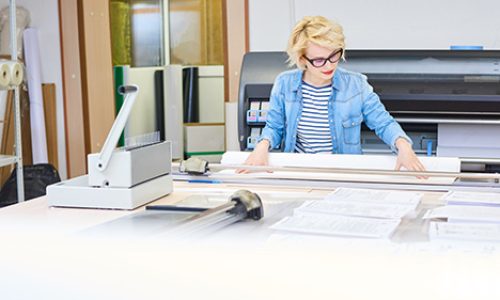
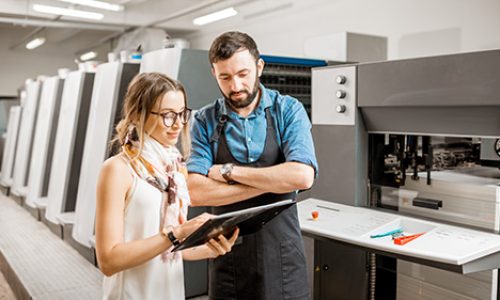
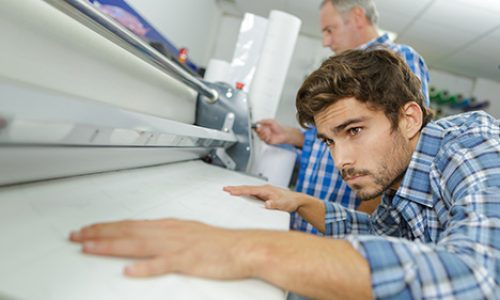

Finishing and binding
Cutting-machine operator
A cutting-machine operator cuts bundles of paper to pages of the desired size, using a computer operated and controlled machine. In this work, the operator makes use of different kinds of ergonomic equipment like paper lift, shaking and transport systems.
Folding-machine operator
Print folding operators tend a machine that folds paper and bundles of paper. Large, printed sheets of paper are fold to brochures or signatures in formats that are used for magazines or books.
Carton-folding/stick-machine operator
A carton-folding/stick-machine operator tends a machine that folds and sticks cardboard to create three-dimensional objects for the packaging industry.
Binding-machine operator
A bindery operator tends a machine that binds printed or unprinted paper into volumes using staples, twine, glue or other binding technologies. A book-sewing machine operator tends a machine that stitches paper together to form a volume and combines this with a book cover.
Die-cutting/emboss-press operator
Paper die-cutting and embossing press operators use a machine with high contact pressure to cut paper or cardboard. Inside the sheets certain areas of the medium can be raised or recessed, so as to create relief on the print. Often the paper is placed between two matching engraved dies and pressure is applied to form the surface of the material or cut it out. In variants hot foil stamping can be applied to create gloss effects.
